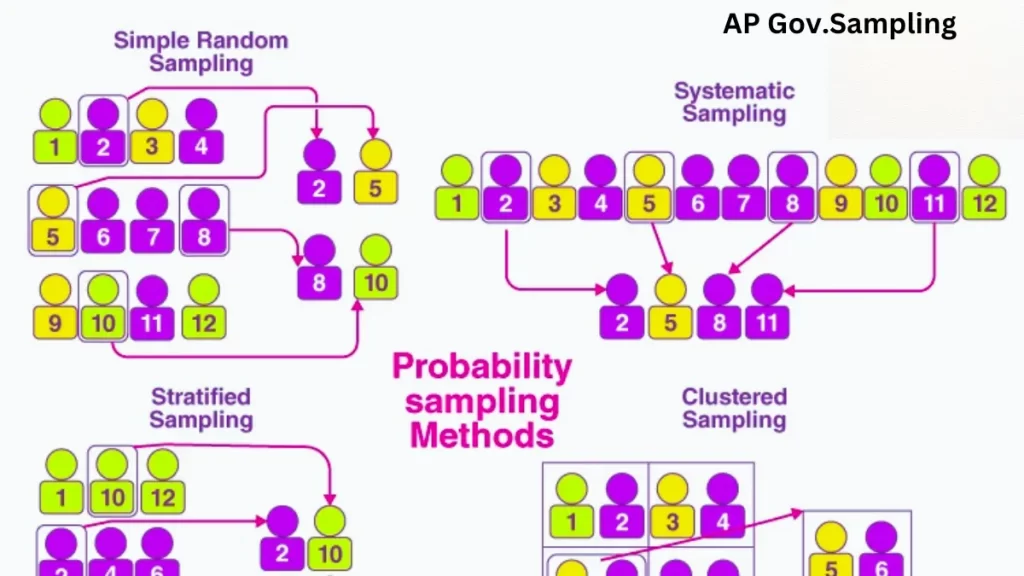Table of Contents
Define Sampling Techniques AP Gov: Understanding sampling techniques is essential for excelling in AP Government exams. For AP Gov students, this resource will clarify sampling procedures with concise explanations and valuable examples. By getting the hang of these tricks, you’ll learn how to get the best scores and be the first to know about all the exciting new developments. Let’s explore sampling strategies and improve your exam readiness.
Define Sampling Techniques AP Gov: What are sampling techniques?
Sampling techniques are methods used to select a portion of a population for study. These methods support data collection and decision-making for researchers at AP Gov. Gaining knowledge will provide a solid basis for political data analysis.
Why Are Sampling Techniques Important?
Define Sampling Techniques AP Gov: Sampling techniques are crucial because they allow researchers to study a more minor group representing a larger population. This saves time and resources while guaranteeing accurate results. Knowing these techniques, you can better understand how political polls and studies are carried out.
Define Sampling Techniques AP Gov: Different Sampling Methods
Several sampling techniques exist, each with a unique process and purpose. Let’s explore the most common ones used in AP Gov.
Simple Random Sampling
The process of simple random sampling is choosing people at random from a population. Everybody has the same opportunity to be selected. This straightforward technique minimizes bias, making it reliable for political studies.
How to Conduct Simple Random Sampling
- Enumerate the People: Enumerate every member of the population.
- Assign Numerics: Assign each person a distinct number.
- Random Selection: Use a random number generator to pick individuals.
Stratified Sampling
Stratified sampling divides the population into groups based on specific characteristics. Subsequently, the researchers randomly choose participants from each group to guarantee representation from every subgroup.
Steps for Stratified Sampling
- Identify Strata: Choose the traits (such as age and gender) that will be used to split the population.
- Divide the Population: Group individuals based on these characteristics.
- Random Selection: Randomly pick individuals from each group.
Systematic Sampling
Every nth individual on a list is chosen via a systematic sampling process. Even coverage of the population is ensured by this easy-to-use and effective method.
Conducting Systematic Sampling
- Make a List: Enumerate every member of the population.
- Choose a Starting Point: Select a random starting point on the list.
- Pick Every nth Individual: Decide on a regular interval (e.g., every 10th person).
Cluster Sampling
Cluster sampling divides the population into clusters, usually based on location. Then, using a random selection process, the researchers examine each individual in each cluster. This method is helpful for large, geographically spread populations.
How to Use Cluster Sampling
- Identify Clusters: Divide the population into clusters based on location or other factors.
- Random Selection of Clusters: Randomly choose clusters.
- Study All Individuals: Collect data from all individuals in the selected clusters.
Define Sampling Techniques AP Gov: Selecting the Appropriate Sampling Method

Selecting the proper sampling technique depends on your study’s goals and population characteristics. Let’s look at factors to consider when choosing a method.
Factors to Consider
- Population Size: Cluster sampling may be advantageous for larger populations.
- Diversity: Stratified sampling is ideal for diverse populations.
- Resources: Consider time and budget constraints.
- Study Goals: Align the technique with your research objectives.
Define Sampling Techniques AP Gov: Typical Sampling Errors
Define Sampling Techniques AP Gov: Mistakes can occur even with the best intentions. Here are some common risks and advice on how to be safe.
Overlooking Bias
Bias can skew results, leading to inaccurate conclusions. Ensure random selection and avoid favoring certain groups.
Inadequate Sample Size
A small sample size can misrepresent the population. Make sure the sample size you choose will yield sufficient, trustworthy data.
Ignoring Diversity
Incomplete data might arise from the failure to consider varied characteristics. To incorporate every category, use stratified sampling.
Define Sampling Techniques AP Gov: Latest Updates in Sampling Techniques
Keeping up with the most recent advancements in sampling strategies might improve your comprehension and utilization. Let’s examine current developments and how they affect AP Government students.
Technological Advancements
Technology has revolutionized sampling methods. Online surveys and data analysis tools have made gathering and analyzing data easier.
Ethical Considerations
Recent updates emphasize ethical practices in sampling. Ensuring confidentiality and obtaining consent are now crucial components of research. Click Here For More Information about the Featured.
Define Sampling Techniques AP Gov: Practical Examples of Sampling Techniques in AP Gov
By using sample techniques in practical contexts, you may reinforce your learning. Here are some valuable examples relevant to AP Gov.
Example 1: Election Polls
Stratified sampling is a common technique used in election polls to reflect different demographic groupings accurately. Based on differing voter opinions, this aids in election outcome prediction.
Example 2: Public Opinion Surveys
Simple random sample may be used in public opinion polls to determine public opinion on political matters. This method ensures every individual has an equal chance of selection.
Gaining proficiency in these sampling strategies will help you perform well on tests and improve your ability to analyze political data. So, keep at it and learn the best AP Gov results methods!




